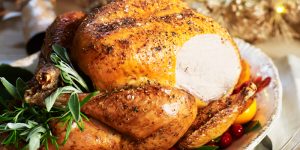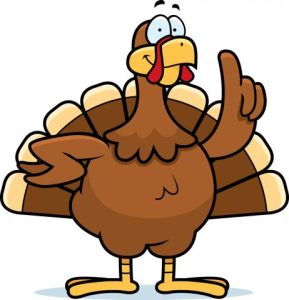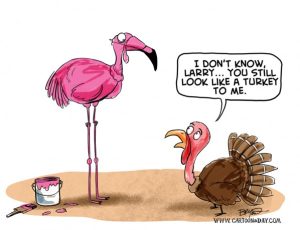 Let’s Talk Turkey… Tips for successfully presenting your Thanksgiving bird.
Let’s Talk Turkey… Tips for successfully presenting your Thanksgiving bird.
Perhaps the biggest holiday meal of the year is just around the corner. Thanksgiving brings families together from all across the state to share a meal that often centers on roast turkey and all the fixings. To help you prepare the holiday meal, University of Wisconsin-Extension food scientist Barbara Ingham offers some helpful hints.
There are plenty of decisions to make when purchasing your Thanksgiving turkey. “Whether you choose a fresh or frozen turkey is up to you,” says Ingham. “But for both fresh and frozen, allow one pound of turkey per person.”
Ingham says there are a few other options you have for your Thanksgiving bird:
- Turkeys to be sold fresh are quick-chilled to 40°F or lower at the processing facility, but must not go below a temperature of 26°F. You may think that turkeys chilled to this temperature would be ‘frozen’, but they aren’t. The low temperature helps to retain quality at the market and in your home refrigerator. The noted advantage of a fresh turkey is that you skip the thawing step; the 4-5 days when the turkey is taking up room in your refrigerator. If you purchase a fresh turkey, keep it refrigerated and cook within 1 to 2 days from purchase. For safety, place a fresh turkey in a pan or on a tray on the bottom shelf of the refrigerator; the pan will catch any juices that may leak. “Do not buy fresh pre-stuffed turkeys,” advises Ingham.
- Most turkey are sold frozen. At the processing plant, a commercial blast freezer quickly takes the turkey to a freezing temperature, ensuring optimum safety and quality. They are then stored in freezers at 0°F or below. Thawing a frozen turkey may take 4-5 days in the refrigerator. If you want to purchase a pre-stuffed turkey, the USDA states that it should be purchased frozen, not fresh. The USDA notes that, “Frozen pre-stuffed turkeys are safe because they have been processed under controlled conditions.” Further, the USDA instructs consumers not to thaw pre-stuffed turkeys before cooking, but to cook them from the frozen state.
- The term ‘natural’ on a turkey label indicates that the product does not contain any artificial flavor or flavoring, coloring ingredients, chemical preservative, or any other artificial or synthetic ingredient. Natural is not a synonym for ‘organic’ or ‘healthy.’
- Self-basting turkeys.These birds are injected or marinated with a solution designed to help keep the meat juicy and flavorful. The basting solution usually contains butter or other edible fat, broth, stock, or water, plus spices, flavor enhancers, and other approved substances. Labels must include a statement identifying the total quantity and common or usual name of all ingredients in the solution, e.g., “Injected with approximately 3% of a solution of _____________ (list of ingredients).”
- Free range or free roaming terms on a label imply that the birds had continuous, free access to the out-of-door for over 51% of their lives.
- Turkeys can also be labeled with terms such as fryer-roaster (a young turkey, usually less than 16 weeks of age); hen (a female turkey); or tom (a male turkey). The terms ‘hen’ and ‘tom’ are an indication of size rather than tenderness, with tom turkeys generally larger than hens.
- Kosher labels can be used only for turkeys that are prepared under Rabbinical supervision.
- Turkeys labeled with the USDA organic sealare raised on a farm that complies with the USDA Organic Standards and are processed in a facility that also meets certain standards.

If your turkey is frozen, keep it frozen until you’re ready to thaw it. “There are three ways to safely thaw your turkey: in the refrigerator, in cold water, or in a microwave oven,” says Ingham.
Thawing your turkey
- Refrigerator(40°F or below): Keep the turkey in its original wrapper. Thaw in the refrigerator on a tray or in a pan to catch drips. Once it is completely thawed, the turkey may be stored in the refrigerator an additional 1 to 2 days before cooking. Allow 4-5 days to thaw an average 20-pound turkey in the refrigerator.
- In cold water:Make sure the turkey is securely wrapped so that water is not able to leak into the package. It’s usually best to keep the turkey wrapped in the original package,. Completely submerge the turkey in cold water. Change the water every 30 minutes as the water starts to warm. Turkeys thawed in this way should be cooked immediately after thawing. Do not refrigerate or refreeze.
- Here are some thawing guidelines.
Size of turkey:
- 4 to 12 pounds–thaw 1 to 3 days in the refrigerator or 2 to 6 hours in cold water
- 12 to 16 pounds–3 to 4 days in the refrigerator or 6 to 8 hours in cold water
- 16 to 20 pounds–4 to 5 days in the refrigerator or 8 to 10 hours in cold water
- 20 to 24 pounds–5 to 6 days in the refrigerator or 10 to 12 hours in cold water.
Thawing In the microwave oven: Check your owner’s manual for the size turkey that will fit in your microwave, the minutes per pound and the power level to use for thawing. Remove all outside wrapping and place on a microwave-safe dish to catch any juices that may leak. Cook your turkey immediately after thawing. Do not refreeze or refrigerate a turkey after microwave thawing.
Roasting your turkey
- Set your oven temperature no lower than 325°F.
- Place your turkey or turkey breast on a rack in a shallow roasting pan.
- For optimum safety, stuffing a turkey is not recommended. For more even cooking, it is recommended you cook your stuffing outside the turkey in a casserole dish. Use a food thermometer to check the internal temperature of the stuffing. The stuffing must reach a safe minimum internal temperature of 165°F.
- If you choose to stuff your turkey, the ingredients can be prepared ahead of time; however, keep wet and dry ingredients separate. Chill all of the wet ingredients (butter/margarine, cooked celery and onions, broth, etc.). Mix wet and dry ingredients just before loosely filling the turkey cavity. Cook the turkey immediately. Use a food thermometer to make sure the center of the stuffing and the turkey reaches a safe minimum internal temperature of 165°F.
- A whole turkey is safe when cooked to a minimum internal temperature of 165°F as measured with a food thermometer. Check the internal temperature in the innermost part of the thigh and wing and the thickest part of the breast.
- For safety’s sake, don’t rely solely on the turkey’s pop-up doneness indicator. Use a thermometer to double-check that the temperature of the turkey in the innermost part of the thigh and wing and the thickest part of the breast reaches 165° F.
- For quality, let the turkey stand for 20 minutes before carving to allow juices to set. The turkey will carve more easily.
- Remove all stuffing from the turkey cavities.
Timetables for turkey roasting (325°F oven temperature)
Use these approximate timetables to determine how long to cook your turkey. Always use a food thermometer to check the internal temperature of your turkey and stuffing.
Thawed, unstuffed cooking time:
- 4 to 8 pounds (breast)–1.5 to 3.25 hours
- 8 to 12 pounds–2.75 to 3 hours
- 12 to 14 pounds–3 to 3.75 hours
- 14 to 18 pounds–3.75 to 4.25 hours
- 18 to 20 pounds–4.5 to 5 hours
- 20 to 24 pounds–4.5 to 5 hours
Thawed, stuffed cooking time:
- 4 to 6 pounds (breast)–not usually applicable
- 6 to 8 pounds (breast)–2.5 to 3.5 hours
- 8 to 12 pounds–3 to 3.5 hours
- 12 to 14 pounds—3.5 to 4 hours
- 14 to 18 pounds–4 to 4.25 hours
- 18 to 20 pounds–4.25 to 4.75 hours
- 20 to 24 pounds–4.75 to 5.25 hours.
It is safe to cook a turkey from the frozen state, but the cooking time will take at least 50 percent longer than recommended for a fully thawed turkey. To cook a frozen turkey, remove the bird’s wrapping and any gravy packet, if present. Place the turkey on a rack in an oven pre-heated to at least 325°F. The time required for cooking will depend on the size of the bird. After the bird has thawed sufficiently in the oven (2-3 hours of cooking), take the turkey from the oven and remove the giblets and neck. It will take 4-1/2 to 5 hours to cook a 12- to 13-pound turkey from the frozen state and longer for larger birds.
“Always wash your hands, utensils, the sink, and anything else that comes in contact with raw turkey and its juices with soap and water,” Ingham says. Ingham offers a few more optional cooking hints:
- Do not rinse turkeys, or other meat, before cooking; this only spreads germs. Use paper towels to gently remove pin feathers or blood.
- If your roasting pan does not have a lid, you may place a tent of heavy-duty aluminum foil over the turkey for the first 1 to 1.5 hours. This allows for maximum heat circulation, keeps the turkey moist and reduces oven splatter. To prevent over-browning, foil may also be placed over the turkey after it reaches the desired color.
For more information, visit http://www.foodsafety.gov/blog/thanksgiving_plan.html
For more information about food safety in English and Spanish, call the USDA Meat and Poultry Hotline, 9 a.m. to 3 p.m. Monday through Friday at: 1-888-MPHotline (1-888-674-6854)
You can also e-mail mphotline.fsis@usda.gov or visit “Ask Karen,” the FSIS web-based automated response system available 24/7 at http://www.fsis.usda.gov/wps/portal/fsis/
Another valuable turkey resource can be found at http://www.butterball.com/turkey-talk-line.
To learn more about food safety, contact your Walworth County UW-Extension Family Living Educator, Amanda Kostman at amanda.kostman@wisc.edu or 262-741-4961.




